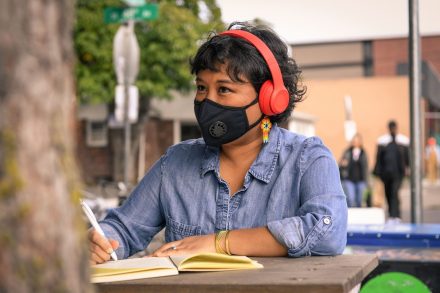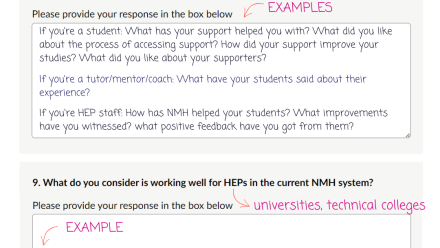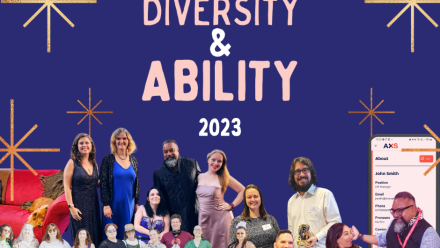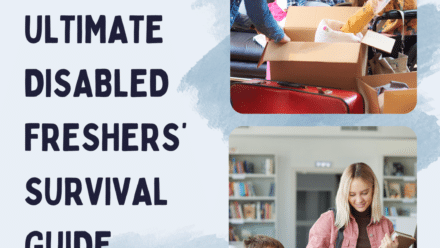Three steps to creating an inclusive campus
24th October 2024 by April Yeatman

We’ve got good news and bad news.
The good news: Every year, more disabled students start university. Over 140,000 more students shared their disability in the 2021/2022 academic year compared to in 2017/2018.
On the surface, these numbers are fantastic! It means either that significantly more Disabled people have begun Higher Education (HE), or that they feel more able to share their disability with their university.
So, what’s the bad news?
It’s a great thing for Disabled students to begin university. But, it’s a different thing for them to be able to fully access it. They need to feel supported, feel like they belong, and achieve their potential in the same ways as their non-Disabled peers.
Most universities weren’t designed with Disabled people in mind. As a result, HE infrastructure is often inaccessible by default.
Lots of universities try to address this by attracting more Disabled students. When universities talk about ‘widening participation’- improving the diversity of their student body- they often set specific targets for the recruitment of Disabled students. The logic is that by improving Disabled representation, access will improve.
But, inclusion efforts often stop once students arrive at university. The outcome of this is lower educational attainment, higher unemployment rates, and higher dropout rates for Disabled students, compared to their non-Disabled peers.
If your only priority is getting Disabled students enrolled (and paying fees), you’re not including them. You need to also support them to succeed.
Yes, it’s a complex undertaking. But making your educational institution fully accessible is possible. More importantly, it’s essential – both morally and under the Equality Act 2010.
So, the million-dollar question: what does it mean for a campus to be truly inclusive, and how can you make that happen?
What is an Inclusive Campus?
In a nutshell, an inclusive campus is an educational space where all students, staff, and visitors can feel like they belong. Here, we’ll talk specifics of two key features: anticipatory welcome and universal design for learning.
Anticipatory Welcome
An anticipatory welcome is when difference is expected, supported, and celebrated.
Expect diverse people to access your spaces and services, and put in place measures to meet different needs as standard. You’re reducing (or even removing) barriers to participation, before Disabled people need to ask. For example, ensuring all teaching spaces have clearly-signposted step free access as standard.
Support your staff and students by creating resources that everyone can access. For example, have wellbeing support available for any member of your community (including staff) to self-refer to.
Celebrate diversity by showing people that you appreciate and embrace their differences. For example, marking key dates in the Equity, Diversity, and Inclusion (EDI) calendar with events, campaigns, and acknowledgement on social media. Remember to centre the voices and lived experiences of people you’re celebrating!
The foundation of an inclusive campus is this anticipation and welcoming of difference.
Universal Design for Learning (UDL)
UDL is an educational framework that promotes building inclusion into your teaching and learning from the very beginning.
Through flexibility and inclusion in teaching, learning and assessment, it ensures all students can fully engage with their education.
Rather than ‘adjusting’ the learning process when the need arises, UDL removes those barriers from the start. In doing so, UDL improves educational outcomes for all learners (not just Disabled people).
How can you work towards an Inclusive Campus?
Step 1: Adopt An Intersectional Social Model Of Disability
The Social Model of Disability enables us to recognise ‘disablement’ as a systemic issue. Rather than seeing Disabled people as having a deficit, the social model recognises that it’s societal barriers that disable people.
It decentres medical diagnoses and instead focuses on how society could (and should) be improved to better include everyone. Learn more about the social model of disability.
What’s more, the social model helps us to understand that we face barriers due to many aspects of our identity, not just disability. It recognises our complex, intersectional experiences; age, race, gender, class, religion (and more) all interact with one another to impact a person’s lived experience and the barriers they face. Learn more about intersectionality. By recognising intersectionality, you’ll learn to consider the whole person.
For example, not everyone has the same access to a formal diagnosis of a disability. Women, people of colour, and LGBTQI+ people face discrimination within healthcare systems, and are therefore less able to access formal diagnosis. Don’t gatekeep your student support based on formal diagnoses; allow students to self-identify and you’ll be including students who face the most significant barriers. Even better: allow them to communicate their needs using a holistic, barrier-focused tool like AXS passport.
Step 2: Centre Lived Experience
Being informed by the lived experience of Disabled folks is key. An important saying and standard in the Disabled community is “Nothing about us, without us”. They’re the people navigating systems not designed for them – they’ll know best what the barriers they’re facing are.
The easiest way to do this is by including Disabled people in your design processes. Talk to your Disabled students about what barriers they face to learning. Listen to what your Disabled staff have to say about your workplace reasonable adjustments policy and process. Work with external organisations that are led by Disabled people, so that you know you’re accessing advice and training that’s driven by genuine lived experience perspectives of disablement.
You could hold a focus group or send out a survey, but please remember that time is a precious commodity and compensate those involved. Don’t expect students to give up time for free, especially when the cost of living is so much higher for Disabled people.
You should also read the Disabled Student Commitment (DSC), and investigate if your institution is signed up. The DSC sets out some clear guidelines from the perspective of Disabled people on how to make sure Disabled students are supported and included.
Step 3: Invest in Inclusion
Yes, we know that HE budgets are in crisis. But you can’t deprioritise removing barriers to learning and participation.
So, why invest in inclusion now? Well, there’s the obvious moral imperative. But there’s more reasons, too.
It’s cheaper to build an accessible lecture theatre than retrofit it later.
It’s easier to invest in ensuring your staff are equipped to support students than to be sued under the Equality Act.
It’s better to make your campus an inclusive and welcoming space now than miss out on future applicants through inaccessibility.
The number of Disabled students in HE is only going to increase. They’ll choose a provider based on many factors – but the accessibility of the institution and course will be their primary concern.
Investing in inclusion is the right thing to do. It also safeguards your university’s reputation and finances into the future.
Start making your campus more inclusive.
Book a consultation to find out how we can support you!


